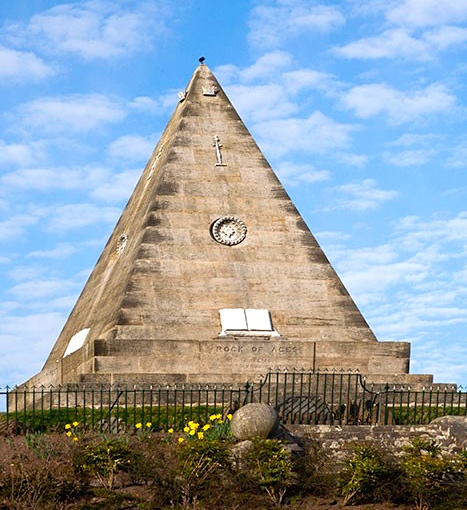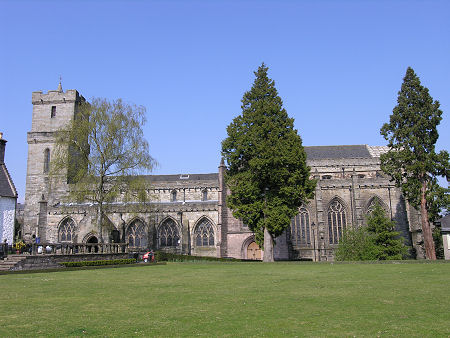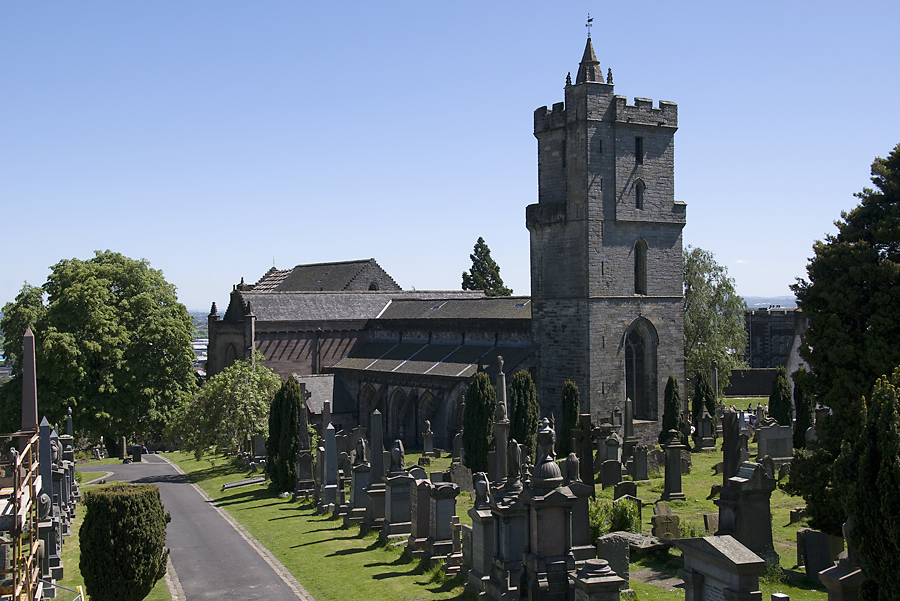The Star Pyramid in Stirling, Scotland
Presented By
Robert Silverstein

The Star Pyramid at Drummond’s Pleasure Grounds
Located just below Stirling Castle and across the driveway from Valley Cemetery is the Drummond’s Pleasure Ground. This is the site that houses Scotland’s Star Pyramid. The Star Pyramid is a mammoth sandstone-ashlar pyramid that is set upon a stone (4) step base that is on a shaped grassy mound. Circling around the pyramid is a wrought iron fence that was once flanked by 2 stone globes that were surmounted by bronze Eagles. Located on the base of each side of the pyramid’s face are similar white marble stones that were cut in the shape of an open Bible. Inscribed in the marble pages were verses from the book of Pslams. Unfortunately, the sunken relief of the biblical texts are mostly worn away from centuries of erosion, but the lower part is still readable. Some distance above each of the marble bibles is an ornate carved circular rosette that is then followed by the Scottish Thistle and a decorative Crown. Inside the pyramid is
William Barclay commissioned noted nurseryman William Drummond in 1863, to build an astrological pyramid that incorporates both religion and Scottish social history. Barclay and Drummond’s idea was to dedicate a long lasting monument to all the Scots who suffered martyrdom in the cause of religious and social liberties in Scotland. The site was most likely chosen to reflect the countries historical events that took place on the grounds and in the surrounding area. One might even say that it is a national hallmark of religious and social occurrences that ended-up reverberating throughout Scotland’s social and political infrastructure that is even reflected today.
Draft Notes:
The pyramid is on a raised plinth of 4 steps and has a set of steps leading to it. Each of the faces are very similar. On one face is a circular marble plaque, the text of which is very worn and some of the lower part is readable.
Each of the sides has (from bottom to top):
sunken relief text with a reference to verses from the Psalms:
Union Banner, XLV CIII
Rock of Ages, XCV
Covenant Rest, CXXXII CXLV
Thrown of Right, XCVI XCVII
marble bible
carved circular rosette
thistle
crown
William Drummond was a land surveyor, evangelist, and a noted nurseryman by trade. The intent was to incorporate Scottish social and religious history directly into the construction of the pyramid. Meaning he combined the undercurrent theme of Scottish Royal history along with religious and social significance. His intent for the pyramid’s grounds was to create a public botanical pleasure garden with trees, bushes and plants. ( It is contemplated that the site was chosen because of William’s personal obsession with religion, but his loyal patronage toward Scottish Royal history. The Drummond family was already a well known throughout Scotland as a prominent family who’s accomplishments included a successful agricultural business and earlier museum. In prior centuries this land below Stirling Castle was used as a market place of sorts, and also common fair ground that would host popular Jousting tournaments. Years later turned into Valley cemetery.

The Church of the Holy Rude (Cross) in Stirling Scotland
The Church of the Holly Rude was the first church built in relation to Stirling Castle. It was built of wood sometime in the 12th century, and reflected the religious beliefs of the Scottish nobility and their countrymen. Because of its proximity and links with Stirling Castle, the church received strong support and patronage from the line of Stuart Kings during the 15th, 16th, and the early part of the 17th century. It is also the only active (re-built) church in the United Kingdom to this day aside from Westminster Abbey to have held a coronation. Earlier writings also denotes to the fact that inside the original church each local artisan guild maintained their own alter in recognition of their Patron Saint. We know that the Burgesses built their own private chapels including one for Saint Andrews. Unfortunately in 1452, most of the church and it’s town was burned down in revenge of King James II who was murdered by the Earl of Douglas. Other later notable historical events include: King James VI baptism in 1567, Mary the Queen of the Scots was known to use this church for worship, and her son James VI was crowned there in July of 1567. In the mid 17th century, religious disputes erupted by rival ministries and the church was divided into two by a wall which stood until 1936.
We know that the first church was built
The Star Pyramid Star pyramid
There are no gravestones within Drummond Pleasure Ground other than William Drummond’s sarcophagus to the NW of the pyramid; polished grey granite inscribed ‘Born 14 February 1793 Died 25th November 1888′ on its stepped base.
Outside the church is the Valley Cemetery. In past times was the site of jousting tournaments and markets. The Cemetery has a Pyramid, built by William Drummond in 1863.
William Drummond was a land surveyor and nurseryman whose immediate descendants were a well known family in Stirling. They were responsible for a wide range of activities both locally and nationally. These included the establishment of an agricultural museum in the 1830’s, an extensive seed and nursery business, exploration in Africa and the Drummond Tract Enterprise, the foremost 19th century publisher of religious pamphlets.
William was the eldest son of the well-known Stirling family which included Peter Drummond and his nephew Henry. He was one of the instigators of the Valley Cemetery and his obsession with religion can be seen in the Martyrs’
Monument and the Star Pyramid (also known as Salem Rock).
He commissioned the Star Pyramid from William Barclay in 1863 – note the white marble Bibles incorporated by Barclay round the base of the edifice and the names of religious tracts (published by his brother Peter’s “Drummond Tract Enterprise”). The Pyramid is dedicated to all those who suffered martyrdom in the cause of civil and religious liberty in Scotland.William planted a Pleasure Garden round the Pyramid, complete with trees and plants. He also paid for five of the six statues seen in various parts of the graveyard and donated trees to be planted round the National Wallace Monument.
This area was laid out as a public pleasure ground by local nurseryman and evangelist, William Drummond. The Star Pyramid, with its texts and emblems, was nearing completion in April 1863, when a bible and the Confession of faith were sealed into a chamber within the structure. It recalls the principles of the Reformation and publicised the famous Drummond Tract Enterprises.
He commissioned the Star Pyramid from William Barclay in 1863 – note the white marble Bibles incorporated by Barclay round the base of the edifice and the names of religious tracts (published by his brother Peter’s “Drummond Tract Enterprise”). The Pyramid is dedicated to all those who suffered martyrdom in the cause of civil and religious liberty in Scotland. William planted a Pleasure Garden round the Pyramid, complete with trees and plants. He also paid for five of the six statues seen in various parts of the graveyard and donated trees to be planted round the National Wallace Monument.
This area was laid out as a public pleasure ground by local nurseryman and evangelist, William Drummond. The Star Pyramid, with its texts and emblems, was nearing completion in April 1863, when a bible and the Confession of faith were sealed into a chamber within the structure. It recalls the principles of the Reformation and publicised the famous Drummond Tract Enterprises.
The pyramid is on a raised plinth of 4 steps and has a set of steps leading to it. Each of the faces are very similar. On one face is a circular marble plaque, the text of which is very worn and some of the lower part is readable.
Separated by a driveway from the Valley Cemetery, the Drummond Pleasure Ground was laid out as a setting for the Star Pyramid which is a massive sandstone ashlar pyramid which dominates this area, standing on a stone stepped base upon a shaped grassy mound. Marble Bibles rest on the base of each face of the pyramid, which is also carved with references to Biblical texts.
The pyramid is enclosed by wrought iron railings, with stone steps to S flanked by 2 stone globes (once surmounted by bronze eagles). A Bible and Confession of Faith were sealed into an inner chamber in the pyramid. The Pithy Mary pond lies to the W of the Star Pyramid with bridge of wrought / cast iron work including later repair work and a grassed slope beyond to the W with lawn and deliberately placed rocks. There are no gravestones within Drummond Pleasure Ground other than William Drummond’s sarcophagus to the NW of the pyramid; polished grey granite inscribed ‘Born 14 February 1793 Died 25th November 1888′ on its stepped base.
Outside the church is the Valley Cemetery. In past times was the site of jousting tournaments and markets. The Cemetery has a Pyramid, built by William Drummond in 1863.
William Drummond was a land surveyor and nurseryman whose immediate descendants were a well known family in Stirling. They were responsible for a wide range of activities both locally and nationally. These included the establishment of an agricultural museum in the 1830’s, an extensive seed and nursery business, exploration in Africa and the Drummond Tract Enterprise, the foremost 19th century publisher of religious pamphlets.
William was the eldest son of the well-known Stirling family which included Peter Drummond and his nephew Henry. He was one of the instigators of the Valley Cemetery and his obsession with religion can be seen in the Martyrs’
Monument and the Star Pyramid (also known as Salem Rock).
He commissioned the Star Pyramid from William Barclay in 1863 – note the white marble Bibles incorporated by Barclay round the base of the edifice and the names of religious tracts (published by his brother Peter’s “Drummond Tract Enterprise”). The Pyramid is dedicated to all those who suffered martyrdom in the cause of civil and religious liberty in Scotland.William planted a Pleasure Garden round the Pyramid, complete with trees and plants. He also paid for five of the six statues seen in various parts of the graveyard and donated trees to be planted round the National Wallace Monument.
This area was laid out as a public pleasure ground by local nurseryman and evangelist, William Drummond. The Star Pyramid, with its texts and emblems, was nearing completion in April 1863, when a bible and the Confession of faith were sealed into a chamber within the structure. It recalls the principles of the Reformation and publicised the famous Drummond Tract Enterprises.
The pyramid is on a raised plinth of 4 steps and has a set of steps leading to it. Each of the faces are very similar. On one face is a circular marble plaque, the text of which is very worn and some of the lower part is readable.
Each of the sides has (from bottom to top):
sunken relief text with a reference to verses from the Psalms:
Union Banner, XLV CIII
Rock of Ages, XCV
Covenant Rest, CXXXII CXLV
Thrown of Right, XCVI XCVII
marble bible
carved circular rosette
thistle
crown
